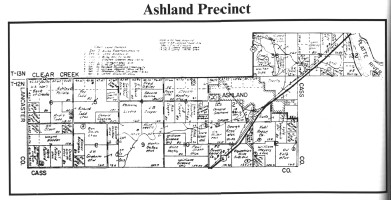 |
| (image links to larger map) |
ASHLAND PRECINCT
Ashland's history is unique in the county because it was the first to be formed. The name of Ashland was given to the town by Mr. Argyle, the man credited with organizing it. He was a great admirer of the statesman, Henry Clay. Ashland was the name of Clay's home in Kentucky.
However, the area had its beginnings as Saline Ford, where the old Government Trail crossed Salt Creek. It became a depot of supplies for the freighters and emigrants. This vicinity was the site of the first settlement in what later became Saunders Co. The fame of this rock-bottomed ford spread throughout the country and was heavily used until the U.P.R.R. was built.
The first cemetery in Saunders Co. was established in 1859 just north of Ashland.
In 1870, there was only one newspaper in the county - The Ashland Times, with a circulation of 600.
Ashland is the smallest precinct in the county, composed of about 14 sections of land, but it's only city, Ashland, is second largest. At about the turn of the century, the largest herd of purebred Herefords found anywhere were on a ranch owned by the Riverford Cattle Co. (later the Riverside Ranch).
Precinct officers 1983-87 are: Chairman - Sanford L. Walkow; Clerk - Orval D. Thiessen; Treasurer - Steven Novotny, Jr.
ASHLAND
Ashland as a town and Ashland as a precinct did not come into being with Calhoun County. Nor were they a part of the county when its name was changed to Saunders during the Civil War.
Ashland Precinct was a part of Salt Creek Precinct of northwest Cass County and was so designated in 1857. Cass County came into a full functioning county status in 1855 as a part of the Nebraska Territory. So Ashland Precinct pre-dates all of Saunders County.
A two-mile strip of land was detached from the six-mile square Salt Creek Precinct of Cass County and was set into Saunders as an act of the Nebraska Territorial Legislature in 1866. Thus 12 sections of land were added to the area of Saunders. Voting, designated roads, along with election officials, were all in place or functioning. Cass County commissioners had taken care of these items of organization. Earliest land records, court proceedings, and the first marriage licenses were all recorded in Plattsmouth before the 12 sections joined Saunders County.
The early population came almost entirely from the eastern states, from Iowa, Illinois, Pennsylvania, Michigan, Indiana, and others.
The history of the town is the history of the precinct. They grew together.
The roads were laid out in the earliest days of settlement and are still used and have been improved through the century.
The only cemetery is Ashland Cemetery. There were two early cemeteries that were abandoned.
The D.L.D. Highway came across Salt Creek out of Cass County to the west side of Ashland Cemetery, turned, and went down Silver Street to 14th. There again, it turned and went north into Clear Creek Precinct to the National Guard Camp and into Sarpy County. This road became Highway #6 in 1931 and then was re-routed close to the C.B. and Q. Railroad tracks, making a diagonal path across the corner of the precinct.
State Highway 66 has a segment discontinued along the south edge of the Clear Creek Precinct. It is called the County Line Road, dating from 1863. A few miles in Cass County are not paved. This road begins at Central City, Nebraska. It runs the entire width of the Saunders County border and ends up at the Mississippi River. It follows closely the wagon road many an early Nebraska homesteader used to come west after the Civil War. It was the Civil War Veterans' road to their new homes on the Prairie.
Following this route, the C.B. and Q. Railroad came to Saunders County in 1870 as did the first telegraph lines. In Ashland Precinct the railroad and telegraph lines turned toward Nebraska's very new Capital, Lincoln.
Ashland was the first sizable town in Saunders County. Its Centennial History was published in 1957.
TOWN OF ASHLAND
Ashland celebrated its 100th anniversary in 1957, which was neither the town's true anniversary nor a date of Ashland's townspeople organizing a village. 1957 was the 100th year of the arrival of the Aughey, Warbritton and Stambaugh families to their wilderness home north of Wahoo Creek about a mile outside Ashland and in a different county than Ashland at that time. The 100th anniversary of the town formation of Ashland went unobserved.
The area of Saunders County was not originally plotted as it is in the 1900s. It was first called Calhoun County and its southern boundary was a straight line westward from the Platte River on the road called the County Line Road. Ashland Precinct, a strip of land 2 miles north and south and 6 miles long east and west was detached from Cass County in 1866 and set over into Saunders County. During the Civil War (1862) the people of Saunders County changed the name of Calhoun to Saunders (for Gov. Alvin Saunders) because Calhoun was a Southerner.
This has been characteristic of Ashland area to change its name of political position. It was first called Saline Ford, a name appropriate to its geographical significance. Fording mud-bottomed and dirt-banked rivers or creeks were great problems for travelers going west in the great rush of migration of the late 1840's, 1850's, and 1860's. Saline Ford was the only natural low water bridge with a lime stone ledge base in the whole trail system to the Rocky Mountains in SE Nebraska Territory. Military shipments and troop movements were routed across Saline Ford. A military supply post was established at about what is now 18th and Clay Street in Ashland in the 1850's. It served the Utah Indian squabbles of that decade. The 49'ers used Saline Ford on their way to California. Later Colorado miners crossed the rocky ford. Finally the overland freighters whose headquarters were in Plattsmouth, Nebraska City, Rock Bluff, and Brownville used the crossing on what was then called the old Freighters Road or the Ox Bow Trail. Tens of thousands of tons of freight in huge, especially constructed overland freighting wagons pulled by lengthy teams of oxen, wended their way diagonally across what is now Saunders County, cutting deep ruts in the native prairies in broad trails the entire width of the county. Many of those old bull whackers, as the drovers were called, later came to claim land in Cass, Lancaster, and Saunders Counties as they had seen the favorable farming terrain as they had crossed the counties on their long hauls. Moses Stocking, John Miller, John Graham, Austin Smith, Abe Fuller, T.T. Young, and others.
page 44
The settlement that was later to become the town of Ashland began in 1850 and 1851. It was a seasonally occupied area. When the winter snows were gone, a huge migration of people began the westward gold rush. Enterprising tradesmen, wheel rights, blacksmiths and hotel keepers set up temporary businesses at the rock crossing on Salt Creek. These men serviced the westward travelers who used Saline Ford as an over night stopping place. The shoeing of animals, repairing of harnesses and wagons were brisk businesses from April to October. Food and shelter were sought. These people usually went to Nebraska City or to Glenwood, Iowa, to spend the winter months and returned in the spring. In the summer of 1854 a family, whose surname was Decker, lived and raised watermelons on the Platte bottom near today's National Guard Camp. They had to guard the melons from Indian thievery and coyote depredations in the fall as the melons ripened. They sold melons to the freighters who were returning from the mountains on their fall trek homeward. The Decker family lived in Plattsmouth settlement in the winter time. Decker descendants married into the Banker Simington family in Ashland and Petersons of Wann. There is a Decker Creek named for this family in Cass Co. They took up summer residences in several spots in the 1850's.
There was enough commerce and smithy work to have held a permanent settlement in 1856. But the fall Indian scare drove most settlers and trail servicing people to the larger towns or over into Iowa. No one remained at Saline Ford. The Stambaughs, Warbrittons and Augheys spent the 1856-1857 winter in Plattsmouth. But William Sheffer and several other families did remain on Salt Creek about 3 miles above its mouth. It was a very severe winter.
In 1853 or 54 a family did construct a dugout in the hills east of Saline Ford. Some one killed all the family members. A 12 or 13 year old girl was away from the farm yard picking berries. When she returned home she found her family slain, mother, father, and small brother. She walked to Plattsmouth down the wagon trail and reported the tragedy. She was sent back to her Missouri relatives.
People wintered over in Saline Ford area in 1857. Trappers, people who took to the trails westward in early spring, idle men and maybe others.
1858-59 and 60 saw more people arrive. George Border, T.M. Marquette's brother-in-law, built a mill. He died of pneumonia, leaving a widow and two small children. His mill was purchased and made operational by Dennis Dean in 1863. Once a mill was operating at Saline Ford, it became a center of commerce.
Other early first residents of Saline Ford were Abe Fuller, Sid Parks, Austin Smith, Israel Beetison (Senator Hazel Abel's grandfather), a man named Wiggins and Moe, Warbrittons.
The town of Ashland was formed in March 21, 1866. School District No. 1, as a free public school, was opened in September 1866. There had been earlier terms of schools held in several places, but these were subscription schools. The first public school teachers in Saunders Co. were Gertrude Clark and Emma Throckmorton.
The first post office in Saunders County was Ashland - Nov. 13, 1866, in the rear of Jack Staat's store. Robert Hinkley was the first postmaster in Ashland. Saline Ford was one of the names submitted for the post office, but Ashland was chosen instead of the first choice name. There was a Salt Creek P.O. and a Saltillo P.O. (south of Lincoln).
The telegraph lines came to Saunders County in May 1869. The railroad in 1870. From 1867 thru 1870, a stage line ran from Plattsmouth to Lincoln. Ashland was an overnight stop-over. This gave rise to a brisk early hotel business to service the stage line.
The county seat was at Ashland for 8 years. An election in 1873 ended in a 3 way split of the county vote to move the courthouse. Due to the very large number of homesteaders who had moved into the Mead area, it became obvious that a new election would have easily resulted in Mead (Alvin as it was then called) winning the 1874 election to legally have Saunders County seat. Some residents of Wahoo illegally removed the county records to Wahoo and then blocked all other attempts to vote again on a regular county seat. Part of the records were sneaked out of the courthouse at 19th Silver St. and taken by buggy to Wahoo. But, most were removed by lumber wagon during a December night in 1873.
Ashland became a boom town as soon as the railroad went through on its way from Plattsmouth to Lincoln and beyond (C.B.& Q.). It became a three county rail head for immigrants. Lumber, coal, tools, merchandise, harness stores, livery stables, hotels, and groceries were big sale items. Wagon freight or dray systems were developed to Wahoo.
The 1870's were a time of drought, privation, and the grass hopper years. Many early settlers sold their holdings and migrated elsewhere. The 1880's saw a new wave of migration, new businesses and a renewed building of railroad mileage. This enlarged the switching tracks and rail head facilities at Ashland.
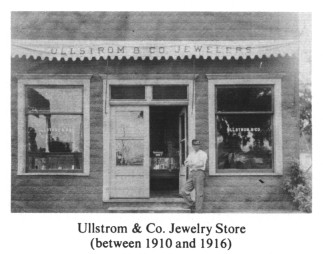 |
Ullstrom & Co. Jewelry Store
(between 1910 and 1916) |
Two huge ice handling facilities were installed on the newly laid Schuyler Railroad line in the early 1890's. Memphis Ice House was built on Ab Williams pond and it was enlarged with dikes and a natural lake bed just north of Ashland became Swift's Ice Plant. Swift's boasted it was the largest ice house in the world. The ice was used by the developing and expanding meat packing industry of South Omaha. Some 150 to 300 men were employed in the winter months harvesting ice. These industries thrived for about 25 years.
Chickerings of the Chickering Piano Company were an Ashland based firm of the 1890's. Bion Arnold, the world renowned electrical engineer, grew up in Ashland. He developed the electrical systems to light cities, electrify railroads and street cars. He built the elevated railway system of Chicago. George Shedd, one of Hollywood's first movie script writers also grew up in this era and went to Ashland's schools. Marble and Brownell became famous barristers.
Brown & Cooley of Houston, Texas fame were first bankers in Ashland. Other bankers were Simington, Wiggenhorn, and White.
Silver Street got its name in the early 1870's because so many men doing business in the "upper" town had used the profits they had gained from the silver mines of Colorado and Utah to start and finance their businesses.
Ashland's first business district had sprung up on Salt Creek bottom at about 11 to 12th and Birch streets. It was called the "Bottoms." After a flood or two a new business district developed on higher ground and these merchants were nicknamed the Silver Street Gang. The name Silver stuck to the street and became the center of the town's commercial activity for the next century. Merchants who moved from the "Bottoms" to Silver Street were Scotts Grocery, Snells Dry Goods, Nichols Furniture, Brush Drugs, Johnsons Meat Market, Huck and Solly's Restaurant, and Vollentine's Mdse.
Ashland's peak growth came about 1910. During the late 1920's and 1930's the population declined and it took until the 1970's for it to regain its population figures of 50 years earlier.
Some parts of Saunders County were settled by European migrants coming directly from Europe, but Ashland area was settled by people from eastern United States. North of Ashland four or five miles was the settlement called the New York Settlement. Near Memphis was the Tennessee Settlement. North of Memphis was the Illinois Settlement. But others came from Connecticut (Chamberlins), or Indiana, or Michigan, or Iowa.
Ashland had a broom factory, a brick kiln, a cigar factory, a harness factory, two flour mills in addition to the early rail head activities. The ice harvest and storage generated lots of activity. From 1957 to 1980 there was thriving limestone quarrying that employed about 250 men. The sand and gravel quarrying began about 1890 and stll continues. It supplies the raw products for the thriving pipe manufacturing plants northeast of Lincoln.
Grain and livestock have from the beginning been the farm's production. Duff, Railsback, Kuhl, Reece, Snell, Farmers Co-op, and now Scoular dealt in grain marketing. Farm machinery dealers have been Forrest Raikes, T. Kiddle, Launes, Harnsbergers, Jack Hull, Martin, F. Graham and Dean.
Auto dealers were R. Barta, Forrest Raikes, Charles and George Gade, C.B. Laune, Andrews, Sapp Bros. and Laughlin.
Bankers were Wiggenhorns, Harnsbergers, Brown, F.E. White, Walton, Frickes, Darst, and Lee Sapp.
Silas Nichols began a furniture business about 1868 or 69 on Salt Creek bottom near 11th and Birch St. He moved to the corner of 15th and Silver and sold his business in the late 1870's to the family that still runs it in the 1980's, Marcy's. It is unique in that its family maintenance has been through a daughter's inheritance, Florence Hartford, Clara Louise Marcy, and Pat Perryman.
Ashland had a number of newspapers. Pickett began in Ashland and ended up in Wahoo. Early editors were W.E.C. Becker, Howard, Corroll, Howe, and Art Riedesel who has been in Ashland now for a quarter of a century.
Oscar Huffman and John Scott dominated the grocery business for long years. Later ones were Carl Poggemeyer, Deb Lacey, Don Seabeck, Harold Cooperman, and Kent's.
Druggists were Brush Bros., Cones, Keedy, Mullen, Harris, and Jack Reece.
Doctors were Von Mansfelde, McClung, Reynolds, Baer, Packer, Williams, Clark, Freiday, and Kirkpatrick.
Dentists were O. Zigenbein, Starns, Henry, Cooper, and Fahey.
FIRST CHRISTIAN CHURCH IN ASHLAND, NEBRASKA
L.C. Barrow and D.R. Dungan, prominent evangelists of the early Eighties, were instrumental in establishing the First Christian Church (Disciples of Christ) in Ashland.
This little band of Christians met in different homes or other available places until 1884, when they decided to build a church; which was dedicated in April 1885. It cost $2908.80.
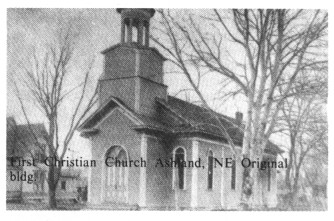 |
| First Christian Church Ashland, NE Original bldg. |
This building was used for Church and Bible School until 1911; when it became too small for the Bible School. So, a wing was added to the west side. It was dedicated January 7, 1912, by Charles Cobbey. Bert Wilson was the minister.
The following ministers have served the Church with distinction and honor: Husband, Williams, Monroe, Henry, Hussong, Kirschstein, Cresmer, Schell, Huyck, Jones, Divine, Lemmon, Hilton, Derry, Gregg, Beattie, Wilson, Lemmon, Ogden, Snapp, Shellenberger, Bicknell, Dennis, MacFarlane, Willson, Stevenson, Dyer, Utterback, Parnell, Foust, Irons, Dubbs (interim) and the present incumbent, Phillip Hayes.
page 45
It is the opinion of many, that the most outstanding service was rendered by C.A. Huyck, who remained steadfast through many difficult years of the Church's life. Reverend Huyck was identified with the congregation from 1891 until his death in 1914. During that time he rendered an uninterrupted service either as Adult Bible Class teacher or pastor of the Church.
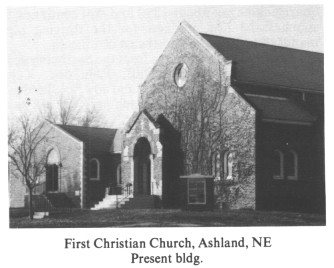 |
First Christian Church, Ashland, NE
Present bldg. |
The Church has been served by many noble women during her time. The Ladies Aid Society was organized in 1896, with Mrs. F.E. Marcy as first president. Her term of office lasted 10 years. During this time, the ladies bought the property just west of the church and presented it to the congregation for a parsonage.
Mrs. J.M. Moss followed Mrs. Marcy as president. She served for 16 years. Many other women served shorter terms.
The Women's Missionary Society was organized April 9, 1891, by Mrs. W.A. Collins, state secretary. The officers chosen were Mrs. A.P. Camp, president; Mrs. C.W. Fuller, vice-president; Miss Addie Marsh, secretary; and Mrs. F.W. Murphy, treasurer.
The Society has rendered a great service to the Church by emphasizing the world-wide call of evangelism.
The Aid Society and the Missionary Society functioned as separate organizations until 1932; when they merged under the name of Women's Council. Mrs. Dean MacFarlane was the first president. In June 1950, it voted to change the name to Christian Women's Fellowship. Mrs. Josephine Ziegenbein was the first president; Mrs. Flora Olson was recording secretary.
At 3:45 a.m., May 17, 1925, the church was discovered in flames. In less than thirty minutes the sacred and tender memories of almost half a century were gone up in smoke. The building and furnishings, valued at more than $15,000 were a total loss. It was covered by only a small amount of insurance. That same afternoon the members met in the Methodist Church and discussed plans for rebuilding. After prayerful consideration the members voted unanimously to rebuild.
A building committee headed by Ed Hoffman was elected. Other members were Earl Chamberlin, L.C. Raikes, Ralph Dean, W.H. Blair, E.F. Steinhaus, and E.R. King. A contract to rebuild was signed June 28, 1926. Ground was broken on July 4th. The cornerstone was laid October 31, 1926. The new church was dedicated April 3, 1927, at a cost of $33,582.25.
The old parsonage showed the ravages of time; so members decided to build a new one. Accordingly, land was purchased just across the street; where a house was built almost entirely of donated labor. This was in the summer of 1956. The cost of the lot and material was $10,400. This new parsonage was dedicated February 3, 1957.
In the early 1950's it had become apparent that more Sunday School space was needed. As a result of this, the Crusader's Class (young adults) several of whom were parents of young children did more than talk about getting that extra space. They began a Building Fund of their own - adding to it each Sunday. Over $3,200 was collected by this class.
As near as could be determined, it was prior to April 8, 1956, when they started their building fund. In February, 1958, the first money was deposited with the Board of Church Extension at Indianapolis. This fund grew until in July 1965, there was $27,834 in the Building Fund, the amount necessary before a contract could be let. Excavating began on June 12, 1965, for the long-planned Educational Unit. Building progressed at a slow pace - due to an enormous amount of rain during the summer. Nevertheless, on January 9, 1966, the Nursery and Beginner's departments began moving into their newly assigned quarters in the new unit. The approximate cost $51,557 plus interest on a loan of $21,000 plus cost of kitchen $4,169 which was paid for by the Christian Women's Fellowship.
ST. STEPHEN'S EPISCOPAL CHURCH
The unique pioneer building is a century and 10 years old. A variety of native woods were fashioned into an unusual building on the frontiers of Nebraska.
It has what is called a barn slant exterior. The boards, as siding, run perpendicular instead of horizontal. A style used when only crudely sawed boards are available. It is supported by buttresses, a style of European cathedrals. The windows were curved as cathedral arches by individually hand-sawn blocks being fit into arches. The re-enforced biased-fit front door has never known a lock or a lock and latch. Yet it has had a very secure fitting. A timber barrack! Hand wrought irons hold a wooden securing device of about 7 ft. long by 6 in. by 2 inches. This timber fits snugly across the inside of the front door. The back door of the church has a lock.
The original benches, kneeling pads, deacon benches, organ pad, and lighting devices are in place. All but two of the original stained glass windows are intact. The hand designed trefoil patterns in pew ends, deacon benches, and choir railing have been nicely preserved.
The original organ still stands at the right of the pulpit. It was purchased in Chicago and delivered via river steamers to Nebraska City. Two Episcopal men drove a team and wagon to Nebraska City and brought the organ to the newly completed church. It cost $150.00.
The communion rail was made of hand wrought iron and hand fashioned wood. Skilled workmen of both iron and wood had to live locally and use their skills effectively to have copied the English Gothic designs of the church and even the spire.
The entire east worship area was a donation of Ernest Wiggenhorn and his sisters in 1940. The woods of that shaded part of the building were in a state of collapse from decay when replaced at that time.
The north service and storage room was added about 1890.
The first rector was Rev. Samuel Goodale. The first wardens were O.M. Carter and Richard Gray. The first five Vestrymen were: J.B. Leininger, A.B. Fuller, C.H. Walker, William Haynes, and G.H. Bascom. Dr. R.H. Clarkson was the Bishop. It had 40 members in 1871. It grew to about 140 communicants before 1900.
This edifice is on the Nat'l Registry of Historical Landmarks.
HISTORY OF THE ASHLAND PUBLIC LIBRARY
The Ashland Women's Club was organized in 1895 for the expressed purpose of founding a library. The club was entirely without funds, and the project was postponed. Late in 1903 Mrs. B.H. Clark joined the effort and related the success story of a library in another town being started under similar circumstances. On Dec. 2, 1903, the club adopted a resolution to begin a library.
A library was opened on April 9, 1904, over Fowler's Barber Shop. This building was located on the south side of Silver Street in the block between 14th and 15th streets. In 1905 the club rented and later purchased a little building which stood on the south side of Silver Street between 16th and 17th streets. In 1908 the city accepted the library without the building under the condition that the Women's Club continue to support the project.
In 1911 E.A. Wiggenhorn gave property on the corner of 15th and Boyd streets for the building of a public library. A building 44 feet by 30 feet was erected at a total cost of $7,000. The Andrew Carnegie Foundation gave a grant of $5,500, and H.A. Wiggenhorn donated the clay tile roof at a cost of $500.
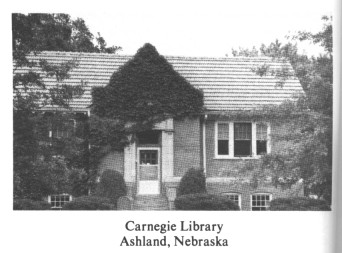 |
Carnegie Library
Ashland, Nebraska |
The exterior appearance of the building remains the same as when it was erected. However, through the years more shelving has been added, the lighting has been upgraded, and the windows and front door have been replaced. Stained glass windows and the light fixture in the entrance are original.
In 1982 the clay tile roof was carefully removed, new felt and copper metal work were put in place, and the original tiles were re-installed.
In the early days of the library it was operated by volunteers. Miss Vera Railsback (Mrs. R.R. Towne) assisted by Miss Augusta Harnsbarger (Mrs. F.A. Jones) were the first regular volunteers. Miss Jessie Scott (married to Mr. Millener) followed Miss Railsback and became the first paid librarian at a salary of $5 per month. At that time the building was open two afternoons and evenings per week and was heated by a wood stove which seemed to be either red hot or stone cold.
The library holdings have grown from 288 volumes in 1904 to 6,500 in 1957 to more than 10,000 in 1982. Through the years a number of services have been added. Many current periodicals have been added. The library is served by the Metropolitan Network van and the Interlibrary Loan Network. In 1980 a collection of microfilms of The Ashland Gazette was started, and the paper is being indexed for births, marriages, and deaths as volunteer time allows.
On Jan. 27, 1983, it was announced by Marvin F. Kivett, State Historic Preservation officer that this library was listed on the National Register of Historic Places.
THE NATIONAL BANK OF ASHLAND BUILDING
The National Bank of Ashland was organized in 1883 and a building was constructed on the corner of 15th and Silver Streets in Ashland in 1889. The building was designed by I. & I. Hodgson, Jr., Architects of Omaha. They had designed and planned the City Hall of Indianapolis, the Exposition Hall in Minneapolis and had moved to Omaha in 1914 where they designed the United States National Bank Building.
The National Bank building is a 2-story brick and stone structure. When built, there was an outside entrance to a basement barbershop. The second floor was occupied by the Lincoln Telephone & Telegraph Co. as their local exchange until 1957 when they moved into a new building. At that time the second floor was made into an apartment which is its present status.
The National Bank occupied the main floor offices until 1933. The Citizens National Bank occupied the building until 1947 when they were purchased by the Farmers & Merchants National Bank and moved across the street. The building was renovated in 1935 at which time the basement exterior stairs were eliminated and the front entrance was enclosed. The basement housed a barber shop until 1930 and is now the Max Carter Photo Studio.
Page 46
The Olson Insurance Agency and Lutton Law Office moved into the building in 1948. The Insurance Agency changed hands several times and was finally sold to the Ashland Agency who moved to their own building in 1977. The main floor was renovated in 1982 to make offices for Claude and David Lutton who joined his father in the Lutton Law Office.
On Jan. 27, 1983, it was announced by Marvin F. Kivett, State Historic Preservation Officer that this bank was listed on the National Register of Historic Places. Submitted by Claude Lutton
ASHLAND STATE BANK
Ashland State Bank was founded by Lee and Helene Sapp on June 7, 1977. The site was purchased and the ground breaking ceremony was held, with the original stock holders present. The charter was approved and in early August of 1977 construction began. The planned completion date was November, 1977. A grand opening was held November 20, 1977 with 380 guests attending, including Governor Charles Thone, Mayor Deb Lacey, and Marvin Killion who was our bank president.
A brief ribbon cutting ceremony was held outdoors on a cold and damp day. Everyone was anxious to continue the festivities indoors, with cake and coffee being served.
On Monday, November 21, 1977 our doors were open for business. Mr. and Mrs. John Fundaburg were our first customers and we are proud to say he is still doing business with us today.
We feel we have come a long way toward meeting banking needs of customers in Ashland as well as the surrounding area. Without the continued community support we could not have grown. But, as our motto suggests, we still remain "small enough to know you and big enough to serve you".
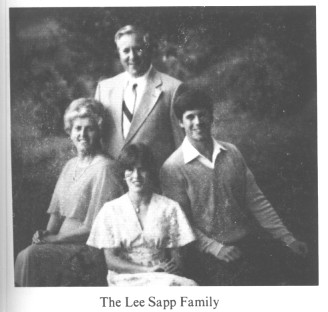 |
| The Lee Sapp Family |
ASHLAND GARDEN CLUB
A group of people met at the Ashland school on Oct. 18, 1949 to organize a garden club. Twenty-three persons signified their interests in the project, 15 of whom are still active participants. In Nov. a constitution and by-laws were drawn up and later adopted, and the Ashland Garden Club came into being. The efforts of one woman, Mrs. Chas. Gade, were largely responsible for this civic organization. She became the first president of the club and her interest has never flagged.
The Club is unique because it had money in the treasury before it was organized. A float in the Stir-Up parade in September 1949, was entered in the name of this projected group and was rated third, thus earning $5. Through her column, "Garden Chatter" a weekly feature in the Ashland Gazette, Mrs. Gade had stimulated enough interest in a garden club among the local residents that a number of people, headed by Miss Sheralee Coatman and Miss Marion Barta, decorated and entered the float in the competition.
To make the Club more efficient, it was separated into Day and Night groups with their own leaders. Meetings are held monthly. Plant sales, flower shows, African violet exhibits, civic plantings, and projects for each group.
A flower show has been held annually by the club since 1950. Flower arrangements are shown in classes and individual specimens of garden flowers, perennials, shrubs and are rated by certified judges and ribbons awarded.
A plant sale is held each spring and fall. Plants are furnished by members of the clubs, which enrich gardens in the surrounding territory.
The African Violet exhibit is an early spring event, grown by the members and sold to visitors. Local growers have exhibited over 200 varieties at one time. Members who raise 100 or more different varieties include Mrs. Carl Parks, Mrs. Frank Backstrom, Mrs. Marion Dimmit, Mrs. Ted Linquist, Mrs. Bert Rager, and Mrs C.E. Barnes.
The Garden Club and the Ashland Chamber of Commerce jointly sponsor a Christmas outdoor decorating contest yearly, with the Chamber furnishing the cash and judged by the Garden Club.
The Ashland civic planting at the east end of Silver Street catches the eye of the visitor as he enters the town. Petunias were planted in 1953. Since then lilacs, iris, mums, cannas have been planted and cared for by the club members.
The Garden Center at 15th and Silver Street is open to the public with potting soil, fertilizers, flower arranging equipment, pots, wren houses and other garden items. A library of books, bulletins, and magazines is available.
The center opened in 1951 furnished through the courtesy of the Farmers and Merchants Bank.
In 1950 the Club affiliated with the Federated Garden Clubs of Nebr.
The oldest member Mrs. Arthur Kellog, has attended three National conferences: Biloxi, Miss. in 1952; San Francisco and Hawaii, 1953; and Charleston, S.C., in 1954. Another tour took Mrs. Kellogg into Canada, Massachusetts, and New York in 1955.
The club has 41 members at this report. The charter members are: Mrs. Leonard Allen, Mrs. Frank Backstrom, Mrs. Elmer Buck, Mrs. C.D. Carey, Mrs. Roy Coatman, Mrs. Marion Dimmit, Mrs. Carl Erickson, Mrs. Chas. Gade, Mrs. George Grauerholz, Mrs. Glen Keetle, Mrs. Lucy Kellog, Mrs. G.E. Mamsfield, Mrs. Chas Narber, Mrs. Raymond Nelson, Mrs. Lloyd Scott and Mrs. Fay Gilkenson.
Of the chartered members that have passed on since 1957 are: Mrs. C.D. Carey, Mrs. Roy Coatman, Mrs. Lucy Kellog, Mrs. Raymond Nelson and Mrs. Fay Gilkenson.
At present the two Clubs are: The Ashland Garden Club that meets at night. The Town and Country Garden Club that meets in the daytime.
The Ashland Garden Club has thirteen members. The club maintains the Rose Circle at the new Wiggenhorn Park. The flower beds at Bethesda Care Center. In the last few years the club has planted two cottonless cottonwood trees, a blue spruce and a Hopa Crab, at the Bethesda Care Center. The club takes care of the lilac planting as you enter Ashland from the east.
The Garden Club and Ashland Chamber of Commerce jointly sponsor a Christmas decorating contest yearly, with the awards furnished by the Chamber and judged by the Garden Club.
The Club has given an agricultural $100. Scholarship the last nineteen years.
When the Ashland Garden Club discontinued their Executive Board, and the two clubs became individual clubs, the afternoon group chose the name Ashland Town and Country Gardeners. Each club has their own projects, the Gardeners have three main ones. At the Ashland Cemetery they have two projects with plantings of evergreens, shrubs, tulips and annuals. At Bethesda Care Center there are two areas, one by the entrance and two smaller ones in the inner court, consisting of roses, tulips, grape hyacinths and various kinds of annuals. The third project is at the Ashland Clinic where the Gardeners have set out three locust trees, five white candle crabapple trees, bulbs and annuals, etc.
Minor projects are scrapbooks for Children's Hospital and gifts to the Rescue Unit and orphanages.
The present membership of the Ashland Town and Country Gardeners is 10 members and one associate member. Taken from the Ashland FIRST 100 Years 1957
ASHLAND LIONS CLUB
The Ashland Lions Club was chartered September 26, 1956. The new group was sponsored by the Wahoo Lions Club, George W. Haessler, president.
The organization's program is civic betterment, and it is hoped to institute a youth program.
The first officers were: B.L. Perryman, president; Kenneth Harris, first vice-president; Ed Ballou, second vice-president; Abe Stoker, third vice-president; Charles Box, secretary-treasurer; Jerald Bates, Lion tamer; Robert Fricke, tail twister; and four directors: Don Hart, Earl Hurst, Don Parks, and Harland Schulz.
ASHLAND ROTARY CLUB
The Ashland Rotary Club organized on May 20, 1935, in a meeting at Ashland, with its parent organization, the Lincoln Rotary Club. The charter presentation meeting was then held on June 7, 1935.
The charter members were Edwin A. Fricke, Carl Panzer, Rev. S.B. Thomas, M. Lynn Judy, Elmer Craig, J.L. Irwin, H.V. Noland, Dr. B.H. Baer, Fred Bontz, W.E. Harnsberger, Roy Churchill, O.J. Lohr, C.D. Lutton, Sr., Kenneth Marcy, Emerson Mead, Earl Miller, James Ziegenbein, Dr. O.H. Ziegenbein, E.F. Burke, E.W. Keedy, John A. Scott, and G.R. Darst.
The Ashland Rotary Club sponsors the local Boy Scout movement, co-sponsors a boy to Boys' State, the March of Dimes drive, and the yearly Boy Scout Drive.
In May, 1955, the Ashland Rotary Club celebrated its 20th anniversary at a banquet held at the First Congregational Church.
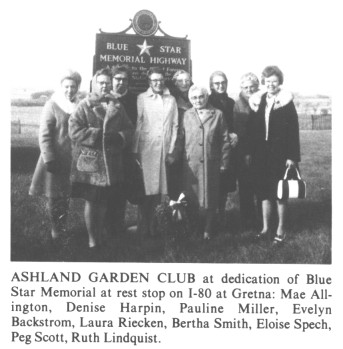 |
| ASHLAND GARDEN CLUB at dedication of Blue Star Memorial at rest stop on I-80 at Gretna: Mae Allington, Denise Harpin, Pauline Miller, Evelyn Backstrom, Laura Riecken, Bertha Smith, Eloise Spech, Peg Scott, Ruth Lindquist. |
page 47
| 
